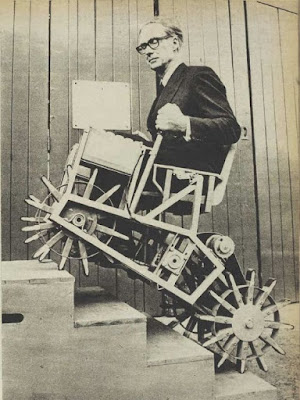Source: Robots and Telechirs, M. W. Thring, 1983.
Thring has worked on an electrically powered carriage with three or four rimless wheels to enable handicapped people to climb stairs freely, which essentially places its spokes (rubber-tipped) on the step in front of it so that like a human foot it has no tendency to roll down the inclined plane formed by the corners of the step, because the weight is always carried on a horizontal surface.
The motion on the staircase is not perfectly steady because the point of contact of the spokes may be very close to, or even right on, the edge of the step, or it may be up to the distance between the spokes from the edge. However, it is considerably smoother than any system which rolls along the step and then climbs up to the next one, and there is a certain smoothing effect between the front and rear wheels.
Figure 6.11 shows an early working model of this kind of machine with four driven wheels having twelve rubber tipped spokes on each. By having driven front and rear wheels it gradually changes angle as it comes to the beginning and end of the stairs. If the spokes are too sharp they wear the rubber tips very fast, but if they are too thick they tend to come on the rounded corner of the step more often and can roll (on the downward movement) or slip (on the upward movement) on to the next step. The optimum number of spokes is also a very important consideration. The wheel should have a radius (when the spoke is loaded) slightly greater than the height of the highest step to be climbed, so that as it rolls forward on the step below the spoke comes forward on to the next step. If there are too many spokes the spoke always begins to lift from a point very close to the edge of the step-tread, and the smoothing effect of the edge going deep between the treads is lost. If there are too few, the reciprocating motion when going on the level ground at higher speed becomes excessive. Twelve spokes give noticeable oscillation at 3 m.p.h. on the level. The amplitude of the oscillation is inversely proportional to the square of the number of spokes, so 16 or 20 would be better from this point of view though more expensive.
There are two problems which must be overcome in a final design.(i) Stability. It is desirable that the seat carrying the person shall tilt so that this seat remains approximately horizontal when the chair ascends or descends stairs. If the chair is pivoted about a point above the centre of gravity of the person so that this levelling is automatic on the pendulum principle, then his weight will be thrown in the downstairs direction on the tilting of the chair, making the system fundamentally unstable. It is, therefore, necessary to tilt the seat about a pivot close to the ground or to slide the seat upstairs as the carriage tilts. In either case the weight has to be lifted and thus the levelling mechanism must be powered, unless the movement is carried out by the driver before reaching the stairs at the same time as he changes to low gear for stair-climbing. It is also possible to have front- and rear-wheel drive only when in the climbing mode.Steering.Steering a system of this type requires front- and rear-wheel drive when it is climbing stairs. Moreover, it should have very good mobility corresponding, if possible, to complete rotation about an axis within the framework. This rules out conventional steering methods unless the driven front wheel can be rotated up to 90° in each direction, a proposal which is being explored at UNAM in Mexico.



No comments:
Post a Comment